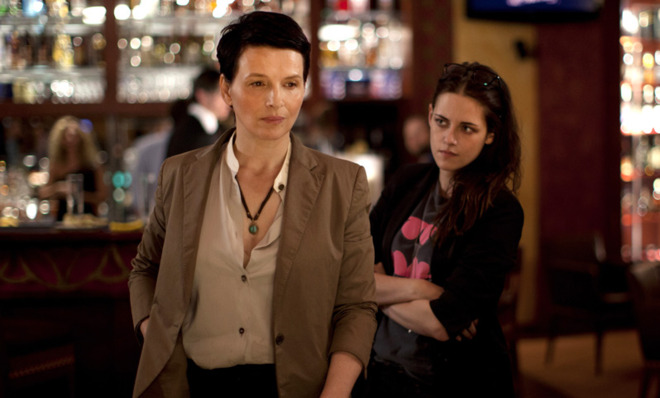Girls on Film: Clouds of Sils Maria is a beautiful look into fame and womanhood
Oliver Assayas answered Juliette Binoche's call for a "deep and complex female role" with this rumination on celebrity


TORONTO — As the Toronto International Film Festival's introduction to the Clouds of Sils Maria reveals, the film would never have happened if star Juliette Binoche hadn't challenged director Olivier Assayas to "write a deep and complex female role." This request — the result of a long-percolating desire to work together again after 1985's Rendez-vous and 2008's Summer Hours — became the spark that created one of the festival's most compelling offerings.
Clouds of Sils Maria matches one of cinema's most lauded actresses (Binoche) with one of Hollywood's most divisive (Kristen Stewart). Binoche plays Maria Enders, a woman whose past and present converge at the height of her career. Sick of working on CGI blockbusters, Maria travels to Sils Maria with her assistant Valentine (Stewart) to accept an award on behalf of Wilhelm Melchior, the man who made her a star 20 years earlier by casting her in a lesbian drama. He dies before she arrives, however, and what was supposed to be a celebration of his craft becomes an entry point into the passing of time.
As she mourns, Valentine urges her to revisit the past with a revival of her first film. But this time, she won't play Sigrid, the deadly seductress; instead, Maria will play Helena, the boss driven to suicide after the tumultuous affair. The actress struggles with the switch; she still identifies with her career-making turn as Sigrid, and struggles with the finality she feels at the thought of playing the older Helena. The woman who originally played the character died soon after, and now her creator has passed too.
The Week
Escape your echo chamber. Get the facts behind the news, plus analysis from multiple perspectives.

Sign up for The Week's Free Newsletters
From our morning news briefing to a weekly Good News Newsletter, get the best of The Week delivered directly to your inbox.
From our morning news briefing to a weekly Good News Newsletter, get the best of The Week delivered directly to your inbox.
The feelings intensify as Maria and Valentine head to Melchior's old home in Sils Maria to prepare for the role, running lines and hitting the internet for gossip on Jo-Ann (Chloe Mortez), the Hollywood wild child who will now play Sigrid. The more they rehearse, the more Maria and Valentine echo Sigrid and Helena — not in sexual provocation, but in intellectual battle.

Remarkably, almost the entire narrative plays out through the interactions between Maria and Valentine: not just as two women communicating, but as two women at work.
But none of the women in Sils Maria are exactly as they appear — not the assistant, either of the actresses, or the widow of the playwright. Each take on roles, or craft stories and situations, to suit the circumstance.
In public, Maria becomes the consummate star in large sunglasses, fur, and perfectly coiffed hair and makeup as Valentine ushers her from commitment to commitment. Alone, the hair is shorn, the makeup gone, and the clothes casual, like any other woman not plagued by the pressures of celebrity. For Jo-Ann, the performance is more overt — she juggles multiple personas, from careless tabloid queen to thoughtful fan, and she can portray any at any given time.
A free daily email with the biggest news stories of the day – and the best features from TheWeek.com
As Assayas noted during Cannes, "An actress has her own life, after all. Then she lives in the place where she stars in the films, and that person lives via the media too. An actress is three different people, if you like, and you have to cope with these different identities and go from one to the other."
He plays with this idea by imbuing Binoche with power in the film, while simultaneously alluding to, and wildly evolving from, the star-making role he gave her in Rendez-vous. In Rendez-vous, Binoche plays Nina, a woman confronting her life as an actress while being plagued by male obsession, abuse, and domination — right down to the director who gives Nina her big break. He is played by seminal French actor Jean-Louis Trintignant, while Anne Wiazemsky (of Au Hasard Balthazar fame) is given nothing more than a cameo role in which she argues with his lust-led decisions. In Sils Maria, however, the male sage is dead and invisible, having passed the torch to Binoche. She is now the sage interacting with and shepherding a new wave of women (Stewart and Moretz) — free of the outdated and problematic male filter.
Stewart, who thrives as Valentine, also gets to inhabit multiple roles. Sils Maria allows her to not only stretch into a new and thoughtful type of character, but own her past as the center of the Twilight series. Throughout the film, Valentine comments on acting and stardom, and Assayas even places Stewart in an argument over the merits of blockbuster cinema — where Valentine argues the depth of one of Jo-Ann's Hollywood roles, which Maria openly mocks.
Clouds of Sils Maria is, simply, a film about women working, thinking, and engaging — a simple concept, but one that finally gives Binoche and her costars the "deep and complex" female roles they deserve.
Girls on Film is a weekly column focusing on women and cinema. It can be found at TheWeek.com every Friday morning. And be sure to follow the Girls on Film Twitter feed for additional femme-con.
Monika Bartyzel is a freelance writer and creator of Girls on Film, a weekly look at femme-centric film news and concerns, now appearing at TheWeek.com. Her work has been published on sites including The Atlantic, Movies.com, Moviefone, Collider, and the now-defunct Cinematical, where she was a lead writer and assignment editor.
-
 Texas is trying to become America’s next financial hub
Texas is trying to become America’s next financial hubIn the Spotlight The Lone Star State could soon have three major stock exchanges
-
 Trump pardons Texas Democratic congressman
Trump pardons Texas Democratic congressmanspeed read Rep. Henry Cuellar was charged with accepting foreign bribes tied to Azerbaijan and Mexico
-
 The Week contest: Primate peck
The Week contest: Primate peckPuzzles and Quizzes
